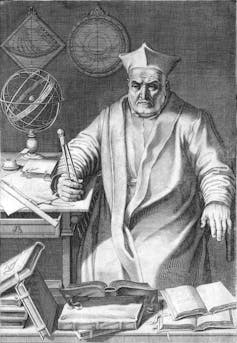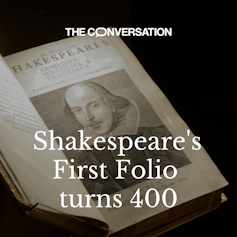Mathematical motifs feature in many of Shakespeare’s most memorable scenes. He lived and wrote in the late 16th century, when new mathematical concepts were transforming perceptions of the world. Part of the role of the theatre was to process the cultural implications of all these changes.
People in Shakespeare’s time were used to the idea of the infinite: the planets, the heavens, the weather. But they were much less used to the inverse idea that the very small (and even nothingness) could be expressed by mathematical axioms. In fact, the first recorded English use of the word “zero” wasn’t until 1598.
Thinkers like Italian mathematician Fibonacci, who lived in the 13th century, helped to introduce the concept of zero – known then as a “cipher” – into the mainstream. But it wasn’t until philosopher René Descartes and mathematicians Sir Isaac Newton and Gottfried Leibniz developed calculus in the late 16th and early 17th centuries that “zero” started to figure prominently in society.
Moreover, scientist Robert Hooke didn’t discover microorganisms until 1665, meaning the idea that life could exist on a micro level remained something of fantasy.

Smithsonian Libraries
With the growing influence of neoclassical ideas in England, small, insignificant figures had begun to be used to represent very large concepts.
This was happening both in modes of calculation (which used proportion) and in the practice of writing mathematical symbols.
For example, during the 16th and early 17th centuries, the equals, multiplication, division, root, decimal, and inequality symbols were gradually introduced and standardised.
Alongside this came the work of Christopher Clavius – a German Jesuit astronomer who helped Pope Gregory XIII to introduce the Gregorian calendar – and other mathematicians on fractions. Then referred to as “broken numbers”, they stirred up great angst among those who clung to classical models of number theory.

This article is part of our First Folio 400 series. These articles mark the 400th anniversary of the publication of the First Folio, the first collected edition of William Shakespeare’s plays.
The struggle to come to terms with the entanglement of the very large and the very small is splendidly displayed in many of Shakespeare’s works. This includes his history play Henry V and tragedy Troilus and Cressida.
The opening chorus of Henry V displays Shakespeare’s interest in proportion and the concept of zero through its repeated “O” and references to contemporary mathematical thought:
O for a muse of fire, that would ascend / The brightest heaven of invention: / A kingdom for a stage, princes to act, / And monarchs to behold the swelling scene […] / may we cram / Within this wooden O the very casques / That did affright the air at Agincourt? / O pardon: since a crookèd figure may / Attest in little place a million, / And let us, ciphers to this great account, / On your imaginary forces work.
Scholars largely agree that Shakespeare’s “crookèd figure” is actually zero. This is despite, of course, the rather obvious objection that zero is the least crooked of all numbers.
In the line “a crookèd figure may / Attest in little place a million”, Shakespeare references 16th century mathematical debates surrounding the idea that the very small is capable of both representing and influencing the very big. In this case, the zero is capable of transforming 100,000 into 1,000,000.

Nick Brundle/Shutterstock
In this mathematical analogy, “crookèd figure[s]” can “attest” much greater things. The chorus suggests that by using one’s “imaginary forces”, much greater things may come from the forthcoming stage performances.
This extended metaphor reappears in Shakespeare’s tragicomedy, The Winter’s Tale when the “cipher” (numbers) transform into many thousands of thank yous:
Like a cipher, / Yet standing in rich place, I multiply / With one “We thank you” many thousands more / That go before it.
There is a further, visual metaphor in Henry V’s opening prologue where the chorus asks pardon of an “O” to help them represent many things in the “wooden O” – the Globe Theatre. This is perhaps evidence of Shakespeare’s ongoing interest in insignificant figures “attest[ing]” much greater things.
Elsewhere in his work, mathematical metaphors encircle themselves in moments of crisis. In Troilus and Cressida, Shakespeare uses mathematical language to chart the slow motion collapse of Troilus’s mental stability after witnessing his lover Cressida’s flirtation with another man.
For Troilus, Cressida disintegrates into “fractions”, “fragments” and “bits and greasy relics”. To mirror this, Shakespeare’s verse descends into jagged pieces, like the early modern name for fractions: “broken numbers”.
With 2023 marking 400 years since the publication of Shakespeare’s First Folio, it is exciting to see how the Bard’s plays spoke to significant developments in the 16th-century mathematical world.
Shakespeare’s plays registered the 16th-century crisis of classical mathematics in the face of newer ideas. But they also offered space for audiences to come to terms with these new ideas and think differently about the world through the lens of mathematics.




